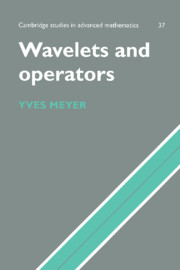Book contents
- Frontmatter
- Contents
- Dedication
- Preface to the English Edition
- Introduction
- 1 Fourier series and integrals, filtering and sampling
- 2 Multiresolution approximations of L2(ℝn)
- 3 Orthonormal wavelet bases
- 4 Non-orthogonal wavelets
- 5 Wavelets, the Hardy space H1 and its dual BMO
- 6 Wavelets and spaces of functions and distributions
- Bibliography
- New references on wavelets and their applications
- Index
Preface to the English Edition
Published online by Cambridge University Press: 24 December 2009
- Frontmatter
- Contents
- Dedication
- Preface to the English Edition
- Introduction
- 1 Fourier series and integrals, filtering and sampling
- 2 Multiresolution approximations of L2(ℝn)
- 3 Orthonormal wavelet bases
- 4 Non-orthogonal wavelets
- 5 Wavelets, the Hardy space H1 and its dual BMO
- 6 Wavelets and spaces of functions and distributions
- Bibliography
- New references on wavelets and their applications
- Index
Summary
The “Theory of Wavelets” lies on the boundaries between (1) mathematics (2) scientific calculation (3) signal processing and (4) image processing. The aim of the theory is to give a coherent set of concepts, methods and algorithms to deal with the difficulties met in each of these disciplines.
Wavelet analysis has come to have applications in widely differing areas of science, because such analysis gives information (of “time–scale” type) about certain signals, images and operators which is more pertinent than that obtained from standard Fourier analysis (or the “time–frequency” methods that derive from it).
The present book has been written by a mathematician and is intended primarily for mathematicians, without forgetting statisticians and engineers working on signal- and image-processing. Our intention has been to take the greatest care in presenting the various constructions of wavelets, and to describe their utilisation within mathematics. The reader whose interest lies in applications of the “wavelet machine” outside mathematics is invited to turn to the second part of the bibliography, which has been specially prepared for the English edition.
I-am very conscious of the honour of being published by the Cambridge University Press and I have admired the quality of David Salinger's translation.
- Type
- Chapter
- Information
- Wavelets and Operators , pp. xPublisher: Cambridge University PressPrint publication year: 1993



